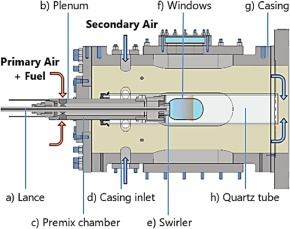Proceedings of the Combustion Institute ( IF 3.4 ) Pub Date : 2018-08-14 , DOI: 10.1016/j.proci.2018.07.091 Daniel Pugh , Philip Bowen , Agustin Valera-Medina , Anthony Giles , Jon Runyon , Richard Marsh

|
There is growing interest in the application of renewably-generated NH3 to support future energy requirements, however combustor designs and strategies require considerable development to reduce NOx emissions in particular. A turbulent swirl burner was used to experimentally and numerically appraise potential pathways for operational NOx reduction with a premixed NH3/H2/air flame. Reactants were supplied at elevated temperature with parametric changes made to pressure and humidity. Favourable agreement was demonstrated between exhaust gas measurements and chemical kinetic simulations with a reactor network model, showing NOx emissions to be sensitive to operational equivalence ratio, increasing by several orders of magnitude across the experimental range. The lowest NOx concentrations were achieved at the richest conditions, accompanied by high unburned fuel fractions in the product stream. An increase in combustor pressure remarkably reduced exhaust NOx concentrations primarily due to enhanced NH2 formation, and subsequent NO consumption in the post-flame zone. Reactant humidification was explored in detail for the first time with this fuel, and shown to reduce NOx production limiting thermal pathways with the extended Zel'dovich mechanism. NO consumption in the post-flame zone was also enhanced through an increase in OH-produced NH2, and together with pressure, resulted in elevated exhaust NH3 concentrations. Whilst this effect was comparatively small, it meant that leaner humidified operation could be employed to reduce unburned fuel fractions without a NOx penalty. Emissions performance was further improved by the application of staged combustion, with secondary airflow used to improve fuel burnout. Humidity and pressure were optimised in the staged configuration to achieve operation with sampled respective NOx and NH3 exhaust fractions of 32 and 50 ppmvd (15%O2), at a globally lean equivalence ratio. There is considerable scope for further system optimisation through improved mixing of secondary air and increased ambient pressure.
中文翻译:

关于NO和升高蒸汽添加的影响的环境条件X在分级预混合回旋NH还原3 / H 2火焰
有一个在可再生生成的NH的应用越来越感兴趣3,以支持未来的能源需求,但是燃烧器设计和战略需要相当大的发展,以减少NO X排放尤其如此。A被用于实验性和湍流旋流燃烧器用于业务NO数值好评潜在途径X与预混NH还原3 / H 2 /空气火焰。在升高的温度下供应反应物,并对压力和湿度进行参数改变。用反应器网络模型在废气测量和化学动力学模拟之间显示出良好的一致性,显示出NO x排放对操作当量比敏感,在整个实验范围内增加了几个数量级。最低NO X浓度分别固定在最富有的条件来实现,伴随着在产物流中高未燃烧的燃料馏分。燃烧器压力的增加显着降低了排气NO x浓度,这主要是由于增加了NH 2的形成,以及随后在燃烧后区域中的NO消耗。反应物增湿进行了详细探讨首次用这种燃料,并显示出降低NO X产生限制与延伸泽尔多维奇机构的热传导途径。燃烧后区域中的NO消耗也通过增加OH产生的NH 2来增加,再加上压力,导致排气中的NH 3浓度升高。尽管这种影响相对较小,但这意味着可以采用较薄的加湿操作来减少未燃烧的燃料馏分,而不会造成NO x损失。分段燃烧的应用进一步提高了排放性能,并通过二次气流改善了燃料的燃尽。湿度和压力进行了优化在分阶段的配置来实现与各自的取样NO操作X和NH 3的32排气馏分和50 ppmvd(15%氧气2),在一个全局贫当量比。通过改善二次空气的混合和增加环境压力,可以进一步优化系统。


























 京公网安备 11010802027423号
京公网安备 11010802027423号